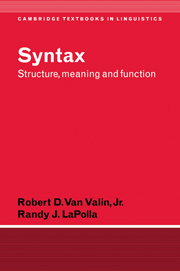Book contents
- Frontmatter
- Contents
- List of figures
- List of tables
- Acknowledgments
- Notes for instructors
- List of abbreviations
- 1 The goals of linguistic theory
- 2 Syntactic structure, I: simple clauses and noun phrases
- 3 Semantic representation, I: verbs and arguments
- 4 Semantic representation, II: macroroles, the lexicon and noun phrases
- 5 Information structure
- 6 Grammatical relations
- 7 Linking syntax and semantics in simple sentences
- 8 Syntactic structure, II: complex sentences and noun phrases
- 9 Linking syntax and semantics in complex sentences
- Epilog: the goals of linguistic theory revisited
- Notes
- References
- Index of languages
- Subject index
4 - Semantic representation, II: macroroles, the lexicon and noun phrases
Published online by Cambridge University Press: 05 June 2012
- Frontmatter
- Contents
- List of figures
- List of tables
- Acknowledgments
- Notes for instructors
- List of abbreviations
- 1 The goals of linguistic theory
- 2 Syntactic structure, I: simple clauses and noun phrases
- 3 Semantic representation, I: verbs and arguments
- 4 Semantic representation, II: macroroles, the lexicon and noun phrases
- 5 Information structure
- 6 Grammatical relations
- 7 Linking syntax and semantics in simple sentences
- 8 Syntactic structure, II: complex sentences and noun phrases
- 9 Linking syntax and semantics in complex sentences
- Epilog: the goals of linguistic theory revisited
- Notes
- References
- Index of languages
- Subject index
Summary
Introduction
In the previous chapter we presented a system of lexical representation for verbs and other predicating elements and their arguments; the logical structures form the basis of the semantic representation for clauses and whole sentences. In this chapter we will fill in the remaining pieces that are needed for semantic representations, in particular the semantic representation of noun phrases and of clausal and NP operators. We will also discuss the lexicon, focusing on what kind of information needs to be represented in lexical entries and in lexical rules. We begin by continuing the discussion of the kinds of semantic relations that an argument can bear to its predicate.
Semantic macroroles
In this book we are presenting a framework for syntactic analysis which directly links the syntactic representation of a sentence, as developed in chapter 2, to the semantic representation, which was developed in chapter 3 (see figure 2.2). The aspects of grammar where these two interact is known as the syntax-semantics interface. The full linking system for simple and complex sentences will be the primary focus of chapters 7 and 9, but we need to introduce an important component of the linking system at this point, since it is tied in with important issues of lexical representation, argument structure and the content of lexical entries for verbs in the lexicon. This is the notion of semantic macroroles. Macroroles are generalizations across the argument-types found with particular verbs which have significant grammatical consequences; it is they, rather than specific arguments in logical structure, that grammatical rules refer to primarily.
- Type
- Chapter
- Information
- SyntaxStructure, Meaning, and Function, pp. 139 - 198Publisher: Cambridge University PressPrint publication year: 1997

